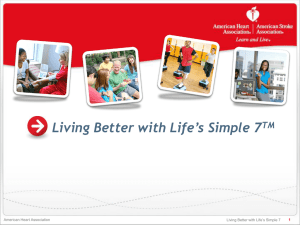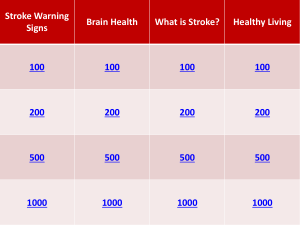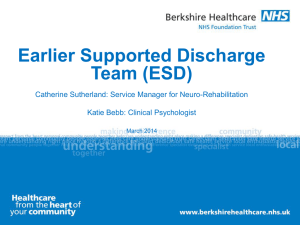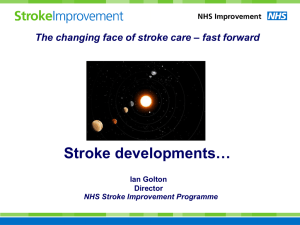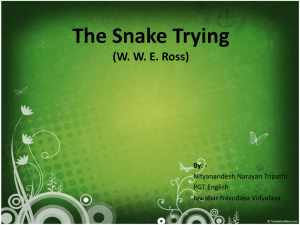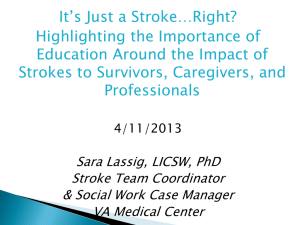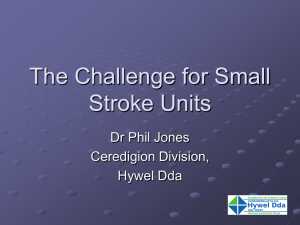Defined-review-best
advertisement
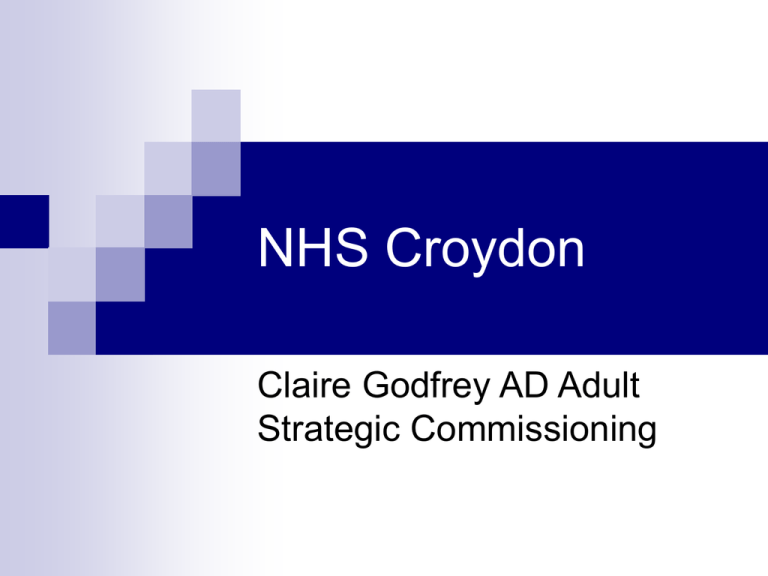
NHS Croydon Claire Godfrey AD Adult Strategic Commissioning Community Stroke Team Consultation with user forums on experience of stroke service Public health needs analysis Mapping current services using LEAN methodology and identifying gaps Development of service specification for community stroke service Redesign of pathway and additional investment to meet demand Commissioning Reviews Consultation with Older People’s Network and Voluntary Sector Providers for Older People Reported feeling “abandoned to cope alone after acute stroke care ended” Informed decision to commission care for all stroke patients and include annual review as part of community stroke specification Pathways within Community Stroke service Community stroke service available to all stroke patients with pathway based on need Stroke Association Carer and Family Support Stroke Groups Communication Support Community Stroke Team intervention including nursing, rehab and generic workers Continuing Care Stroke register with annual reviews all stroke patients Commissioning Reviews Part of stroke co-ordinators role - Responsibility to ensure annual reviews completed Aims to review Care and support delivered via appropriate pathway Appropriate ongoing care and support after rehab phase and types of support received at 1 year Number of patients independent at 1 year Identification of new problems and concerns requiring possible intervention including carer concerns User experience feedback Results to support strategic development and commissioning via stroke steering group Stroke Reviews Pilot Dr Emma Cotterill - Clinical Psychologist Jane Dundas - Stroke Co-ordinator Pilot - Stroke Reviews Developed within Croydon Community Stroke Rehabilitation Team (CNRT) Pilot format – 2 parts to the review Pilot Development team: Jane Dundas, Stroke Co-ordinator Dr Emma Cotterill, Clinical Psychologist Jade Redfern, Assistant Psychologist Darren Beales, Physiotherapist Stroke Reviews Pilot - structure Part 1 Service User Self assessment questionnaire Sent out 4 months post discharge from CNRT (10 months - 1 year post stroke) Telephone follow up if questionnaire not returned, questionnaire completed on telephone Questionnaires scored Passed to stroke co-ordinator for follow up – if opted for this contact Stroke Reviews Pilot - structure Part 2: Stroke Co-ordinator provides telephone follow up or home visit Onward actions: Advice/Information Referrals made to other services/professionals Re-referral for further episode of rehabilitation Review report to GP/Consultant + copy to patient. Issues Raised from Pilot– Part 1 Positive and non intrusive way to reach service users Time saving way of encouraging service users to ‘opt in’ for further review People with communication difficulties or significant cognitive impairment may not be able to complete self assessment questionnaire or telephone questionnaire Self Assessment questionnaire sent to service users – need version for carers? Requires an administration lead on the project e.g. to co-ordinate questionnaires Results of Pilot – Part 2 Patient Feedback Quick, cost free Convenient – no travel Treated as an individual Contact point Telephone not for dysphasic patients but carers able to offload Only 3/18 no further needs - satisfied with telephone contact alone 9/18 satisfied with telephone contact but preferred face to face Remaining 6/18 didn’t mind Stroke Co-ordinator perspective • • • 14/18 face to face preferable Unable to provide holistic assessment on the telephone Additional 9 who requested no contact may benefit from assessment Unable to assess carer needs Stroke Co-ordinator perspective Time pressures Stressful – repeated calls Need for admin support Great for patients who have minimal needs, offers window for future contact Patient needs information about review process at discharge National Stroke Strategy Projected Stroke prevalence Responsibility for review? Pilot completed in CNRT - consider pathwaywide review? Who is responsible? GPs Hospital Stroke Consultants Stroke MDT Essential - Access to patient information Desirable – Previous knowledge of the patient Advantages Questionnaire encourages self assessment Screens patients who have needs and those who don’t Patient choice Carers of patients with dysphasia able to raise issues Disadvantages Patients with impairments, particularly communication/cognition require face to face assessment preferably at home Home visits lasted in excess of one hour Travel time Onward referral process and report writing time consuming The future Applicable to this client group (post rehab) Questionnaires valuable Weekly MDT follow-up clinic (20 patients/month) Led by Stroke (nurse) co-ordinator + access to therapists & psychologist Social services link desirable Assessment proforma Home visit if appropriate Cost implications Transport to clinic Therapy time Admin support Benefits and cost savings Encourages self assessment Stroke prevention General health promotion Self referral pathway Access to information Access to support Positive patient experience Review Pilot Results Pilot -Stroke Reviews – Part 1 Questionnaire: PHYSICAL MEMORY & THINKING Can you tell us about any improvements in your mood & coping since discharge Can you tell us about any problems in your mood and coping since discharge COMMUNICATION Can you tell us about any improvements in your memory and thinking since discharge Can you tell us about any problems in your memory and thinking since discharge MOOD & COPING Can you tell us about any improvements in your physical abilities since discharge Can you tell us about any problems with your physical abilities since discharge Can you tell us about any improvements in your communication since discharge Can you tell us about any problems in your communication since discharge SOCIALISING Can you tell us about any improvements in your social life and social/work activities since discharge Can you tell us about any problems in your social life and social/work activities Results of Pilot – Part 1 Questionnaires Sent 43 Questionnaires completed Questionnaires completed via post Questionnaires completed via telephone 27 (62%) 22 5 Service users/carers who refused/opted out via phone or post 2 Questionnaires unable to complete over telephone due to communication difficulties 5 Unable to make direct contact via phone/post 5 Not returned/other 4 Results of Pilot – Part 1 Questionnaire Data: No significant concerns reported on questionnaire 16 out of 27 wanted to be contacted by stroke coordinator 2 people did not opt either way so were passed to stroke co-ordinator 11 out of 27 highlighted only one area of difficulty on questionnaire 3 people highlighted all 5 areas of difficulty Results of Pilot – Part 1 13 people highlighted physical difficulties 9 people highlighted mood difficulties 8 people highlighted social difficulties 5 people highlighted memory difficulties 5 people highlighted communication difficulties Results of Pilot – Part 2 18 followed up by stroke co-ordinator 10 telephone reviews 8 home visits 1 referred to Falls service 1 referred for further short rehab intervention All provided with relevant written information as required All needed secondary prevention advice Results of Pilot – Part 2 9 referred to Stroke Association – needs for carer support, benefits advice All advised of support groups All advised of educational groups Some medical issues raised with GPs
